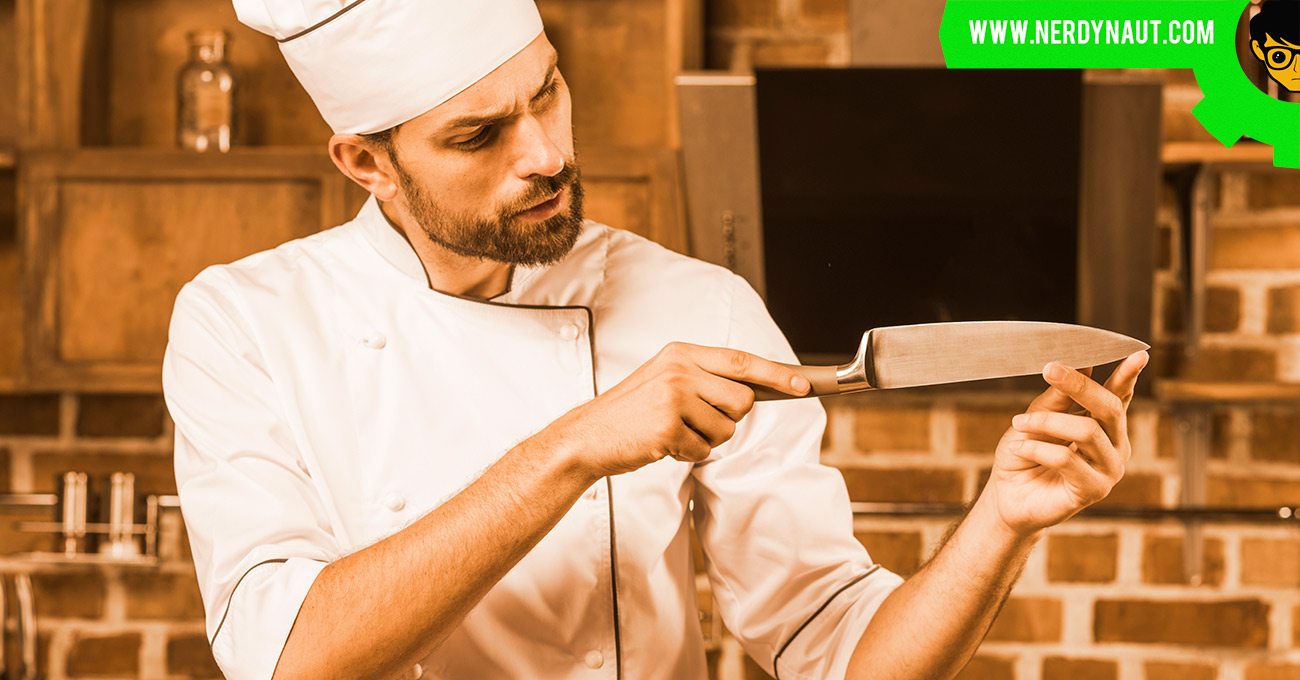
While in the kitchen, a sharp edgy knife would come always in good use. At any case, the sharper the blade, the easier the task gets. However, choosing the correct blade for your chore is tricky. Being bold, they all look alike and shine same but the right knife for your day-to-day activity would save you a lot of your time and energy.
So it’s important to know your blades before you purchase one. Each knife is constructed for its own advantages and drawbacks. On a depth note, most knives have their category of variation and grades, but having a basic knowledge of their blades would provide you an insight which comes in handy when choosing a knife for your task.
Listed down below are a few of the common types of Knife blade materials which are used in day-to-day tasks at domestic Kitchens or even mass scale Kitchens.
Carbon Steel Knife
The most commonly used and the most famous type of blade is the Carbon Steel Knife. Back in the day, Carbon steel blades were used vastly for survival knives, hunting and pocket knives as they were known to be rough on the edges. Although for some period of time the Carbon Steel blade was used in domestic kitchens, its lack of Chromium made it highly susceptible to rust, corrosion and required careful cleaning after each use. With its discolouring nature and overall durability and sharpness compared to other blades, Carbon Steel knives did not make its way into high-quality kitchens.
Stainless Steel Knife
The most famous and easy type of blade to use is the Stainless Steel blade. It outdated Carbon Steel blades with its high-quality durability and resistance to corrosion. Stainless steel is a metal alloy generally made out of at least 11% chromium, iron, nickel, molybdenum and carbon. However Stainless steel has blades vary from many of the same kind due to the percentages and compositions of each blade type. So in general, one would come across different grades and varieties of Stainless Steel blades. While these blades are favoured for its rust-resistance, in certain environments Stainless Steel blades do stain and are not usually as sharp as other materials like Ceramic.
Knives that mostly use Stainless Steel blades include Kitchenware, cutlery items, diving knives and pocket knives.
Ceramic Blade Knife
Ceramic blades are not commonly used in knives or for rough tasks. The advantages of using Ceramic knives include its complete resistance to corrosion, extremely hard blade and ability to maintain sharpness for long time periods unlike Stainless Steel or Carbon Steel blades. The speciality of Ceramic Blades is that it’s non-metallic which gives the sleek smooth outer look. However Ceramic knives are known to be Brittle and Vulnerable to crack under various kind of exposures to shock or pressure. Also, these Ceramic Blade knives have their own tools from only which they could be sharpened.
Due to its overall sensitive nature, Ceramic Blades are used mostly in Kitchen Cutlery, Knives and Pocket knives.
High Carbon Stainless Steel Knife
One of the era’s most useful inventions can be named as the High Carbon Stainless Steel knife. Realizing the advantages and drawbacks in both Carbon and Stainless Steel blades, the High Carbon Stainless Steel Knife is a stunning combination of a creation. While this Metal alloy blade contains relatively high amounts of Carbon which might go up to 1.2% or low as to 0.2% just like Stainless Steel, High Carbon Stainless Steel blades vary according to each grade and composition, making each category different from the other.
The High Carbon Stainless Steel Blade is somewhat completely resistant to rust or staining and due to its rough nature, requires minimal maintenance and sharpening. Although it is a mix of Carbon, it’s mostly thought of as a higher quality Stainless Steel alloy. However, manufacturing High Carbon Stainless Steel Knives are quite tricky if the content of Chromium and Carbon are at the wrong amounts, the final product could not be as expected. Because of this effort on the manufacture, High Carbon Stainless Steel knives could prove slightly expensive than the other ranges of blades in the market. But it is perfect for all kinds of kitchen cutlery in domestic as well as professional kitchens.
Forged Blades vs. Stamped Blades
Forged – Stamped, what’s your pick? By now If you are aware about different blades and knives, you’d come across this pick to be rather difficult.
The kitchen is the best place to witness the true mightiness of a Knife. Especially in a professional kitchen, the power of the blade defines the talent of the chef. Different chefs have their own preferences on their knives. Discussing the famous brawl of the two knives, here are the benefits of each.
The Forged Blade is easy to sharpen as it does not have a tendency to bend while being honed at the sharpening stone, this comes in handy while cutting thin fillets as the firm flexibility helps the knife to go smoothly on the object. The Forging process makes steel stronger and the bolster by the handle makes the user more comfortable with the knife while resting the fingers giving them extra balance and safety.
Stamped knives, on the other hand, are those which are cut from a large sheet of steel, a handle added and the knife finally sharpened. In general, compared to Forged Blades, Stamped Blades are much cheaper and would be cost effective for one if buying a set. Although these knives are made of the same steel as Forged, the blades tend to be more flexible and keeps the edge for a shorter time. Due to this, the user of Stamped blades might have to be extra cautious while using this knife since it has no bolster at the end.
So there it is! Both the steel proves to be the same, just the manufacturer varies. With this basic blade knowledge, now you get to choose your preferences mindfully picking the correct item and brand for your appliances.




